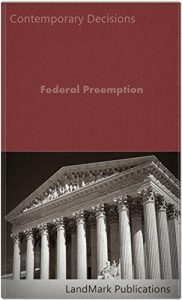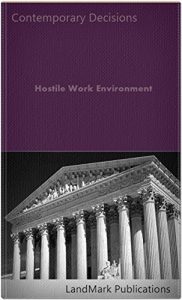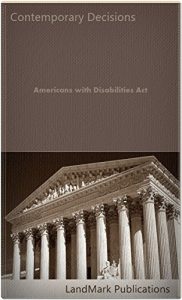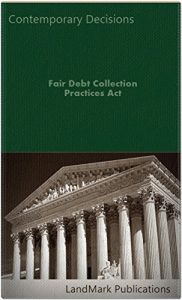THIS CASEBOOK contains a selection of 248 U. S. Court of Appeals decisions that discuss, analyze and apply federal preemption doctrine. The selection of decisions spans from 2004 to the date of publication.
Federal preemption of state law is a "necessary but precarious component of our system of federalism under which the states and the federal government possess concurrent sovereignty." Sikkelee v. Precision Airmotive Corp., 822 F.3d 680, 687 (3d Cir. 2016). Under this dual system, federal and state law coexist peacefully much of the time. But when those laws come into conflict, the Supremacy Clause of the Constitution requires that state law give way to federal law. U.S. Const. art. VI, cl. 2. Rosenberg v. DVI Receivables XVII, LLC, (3rd Cir. 2016).
The Supremacy Clause provides the constitutional foundation for federal authority to preempt state law. See U.S. Const. art. VI, cl. 2 (federal law "shall be the supreme Law of the Land . . . any Thing in the Constitution or Laws of any State to the Contrary notwithstanding."); Kurns v. R.R. Friction Prods. Corp., ___ U.S. ___, 132 S.Ct. 1261, 1265, ___ L.Ed.2d ___ (2012). Preemption of state law, by operation of the Supremacy Clause, can occur in one of several ways: express, field, or conflict preemption. Kurns, 132 S.Ct. at 1265-66. Beaver v. Tarsadia Hotels, 816 F. 3d 1170 (9th Cir. 2016).
Preemption analysis is driven by the presumption that "the historic police powers of the States were not to be superseded by the Federal Act unless that was the clear and manifest purpose of Congress." Wyeth v. Levine, 555 U.S. 555, 565, 129 S.Ct. 1187, 173 L.Ed.2d 51 (2009) (quoting Medtronic, Inc. v. Lohr, 518 U.S. 470, 485, 116 S.Ct. 2240, 135 L.Ed.2d 700 (1996)). This presumption carries the "greatest force" when federal legislation encroaches on an area traditionally occupied by the states, such as the field of property law. CTS Corp. v. Waldburger, ___ U.S. ___, 134 S.Ct. 2175, 2189, 189 L.Ed.2d 62 (2014). Beaver v. Tarsadia Hotels, ibid.
Federal law may preempt state law in three ways. First, "Congress may withdraw specified powers from the States by enacting a statute containing an express preemption provision." Arizona v. United States, ___ U.S. ___, 132 S.Ct. 2492, 2500-01, 183 L.Ed.2d 351 (2012). Second, "States are precluded from regulating conduct in a field that Congress, acting within its proper authority, has determined must be regulated by its exclusive governance." Id. at 2501. Finally, "state laws are preempted when they conflict with federal law," such that "compliance with both federal and state regulations is a physical impossibility, . . . [or] the challenged state law stands as an obstacle to the accomplishment and execution of the full purposes and objectives of Congress." Id. (internal quotation marks and citation omitted). National Fed'n of the Blind v. United Airlines, 813 F. 3d 718 (9th Cir. 2016).
Regardless of the type of preemption involved—express, field, or conflict—"[t]he purpose of Congress is the ultimate touchstone of pre-emption analysis." Cipollone v. Liggett Grp., Inc., 505 U.S. 504, 516, 112 S.Ct. 2608, 120 L.Ed.2d 407 (1992) (alteration in original) (internal quotation marks omitted). "[W]e are mindful of the adage that Congress does not cavalierly preempt state law causes of action." Montalvo v. Spirit Airlines, 508 F.3d 464, 471 (9th Cir.2007) (citing Medtronic, Inc. v. Lohr, 518 U.S. 470, 485, 116 S.Ct. 2240, 135 L.Ed.2d 700 (1996)). National Fed'n of the Blind v. United Airlines, ibid.
Federal preemption of state law is a "necessary but precarious component of our system of federalism under which the states and the federal government possess concurrent sovereignty." Sikkelee v. Precision Airmotive Corp., 822 F.3d 680, 687 (3d Cir. 2016). Under this dual system, federal and state law coexist peacefully much of the time. But when those laws come into conflict, the Supremacy Clause of the Constitution requires that state law give way to federal law. U.S. Const. art. VI, cl. 2. Rosenberg v. DVI Receivables XVII, LLC, (3rd Cir. 2016).
The Supremacy Clause provides the constitutional foundation for federal authority to preempt state law. See U.S. Const. art. VI, cl. 2 (federal law "shall be the supreme Law of the Land . . . any Thing in the Constitution or Laws of any State to the Contrary notwithstanding."); Kurns v. R.R. Friction Prods. Corp., ___ U.S. ___, 132 S.Ct. 1261, 1265, ___ L.Ed.2d ___ (2012). Preemption of state law, by operation of the Supremacy Clause, can occur in one of several ways: express, field, or conflict preemption. Kurns, 132 S.Ct. at 1265-66. Beaver v. Tarsadia Hotels, 816 F. 3d 1170 (9th Cir. 2016).
Preemption analysis is driven by the presumption that "the historic police powers of the States were not to be superseded by the Federal Act unless that was the clear and manifest purpose of Congress." Wyeth v. Levine, 555 U.S. 555, 565, 129 S.Ct. 1187, 173 L.Ed.2d 51 (2009) (quoting Medtronic, Inc. v. Lohr, 518 U.S. 470, 485, 116 S.Ct. 2240, 135 L.Ed.2d 700 (1996)). This presumption carries the "greatest force" when federal legislation encroaches on an area traditionally occupied by the states, such as the field of property law. CTS Corp. v. Waldburger, ___ U.S. ___, 134 S.Ct. 2175, 2189, 189 L.Ed.2d 62 (2014). Beaver v. Tarsadia Hotels, ibid.
Federal law may preempt state law in three ways. First, "Congress may withdraw specified powers from the States by enacting a statute containing an express preemption provision." Arizona v. United States, ___ U.S. ___, 132 S.Ct. 2492, 2500-01, 183 L.Ed.2d 351 (2012). Second, "States are precluded from regulating conduct in a field that Congress, acting within its proper authority, has determined must be regulated by its exclusive governance." Id. at 2501. Finally, "state laws are preempted when they conflict with federal law," such that "compliance with both federal and state regulations is a physical impossibility, . . . [or] the challenged state law stands as an obstacle to the accomplishment and execution of the full purposes and objectives of Congress." Id. (internal quotation marks and citation omitted). National Fed'n of the Blind v. United Airlines, 813 F. 3d 718 (9th Cir. 2016).
Regardless of the type of preemption involved—express, field, or conflict—"[t]he purpose of Congress is the ultimate touchstone of pre-emption analysis." Cipollone v. Liggett Grp., Inc., 505 U.S. 504, 516, 112 S.Ct. 2608, 120 L.Ed.2d 407 (1992) (alteration in original) (internal quotation marks omitted). "[W]e are mindful of the adage that Congress does not cavalierly preempt state law causes of action." Montalvo v. Spirit Airlines, 508 F.3d 464, 471 (9th Cir.2007) (citing Medtronic, Inc. v. Lohr, 518 U.S. 470, 485, 116 S.Ct. 2240, 135 L.Ed.2d 700 (1996)). National Fed'n of the Blind v. United Airlines, ibid.












